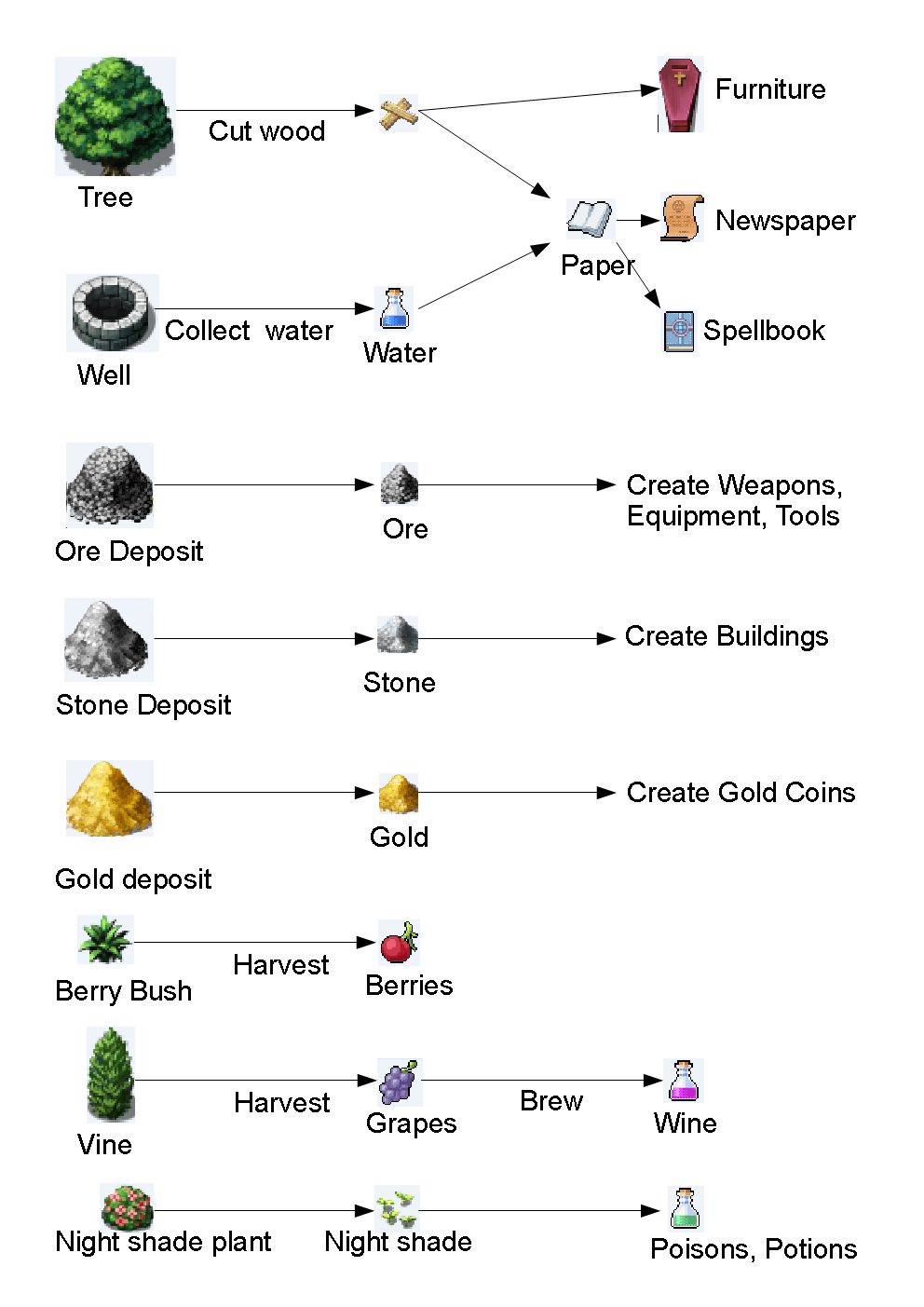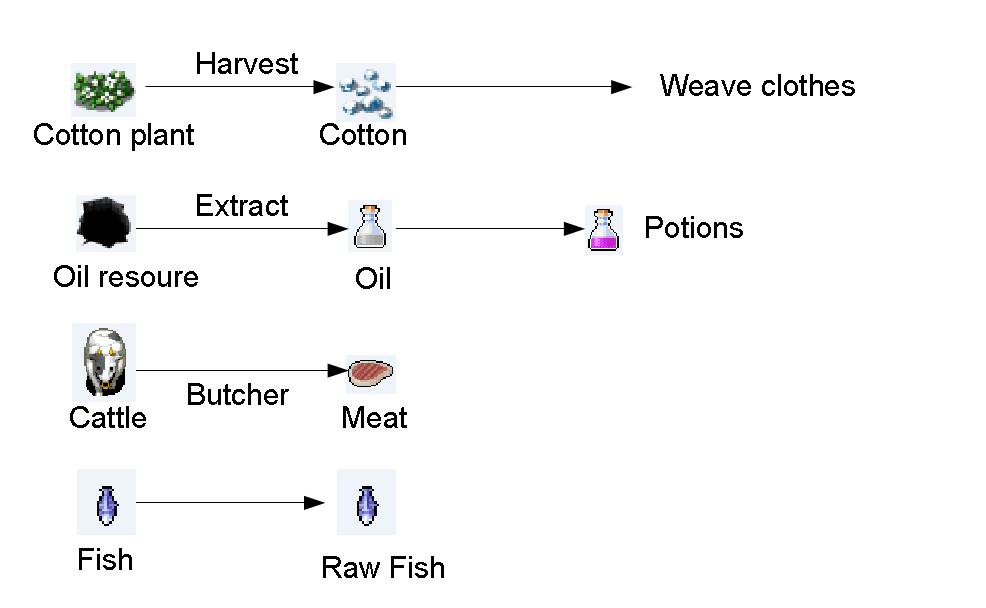WorldGrower User Manual
This page is outdated, and will redirect to the new page in 5 seconds.
Click here to go there manually.
Preface
1. Getting Started
1.1 Start Screen
1.2 Character
Customization screen
1.3 Options Screen
2. Playing
2.1 Controls
2.2 Combat
2.3 Economy
2.4 Skills
3. Screens
3.1 Main Screen
3.2 Character
screen
3.3 Character Menu
3.4 Inventory
Screen
3.5 Magic
Overview Screen
3.6 Talk Dialog
3.7 Governance
Dialog
3.8 Community
Overview
4. How-To Guides
4.1 How to
build a shack
4.2 How
to craft light armor
4.3 How
to learn magic spells
4.4 How to
regain energy
4.5 How to
build a house
4.6 How to get
food
4.7 How to get
water
Preface
WorldGrower is a turn-based, 2d top-down rpg with a fantasy theme,
in which actions have consequences.
It focuses on skills, dialogue, economy and society.
Chapter 1. Getting
Started
1.1 Start Screen
When WorldGrower first starts up, it displays the Main menu.

New Game
Starts a new game, this is either the tutorial,
standard or custom game.
A custom game shows the Options menu.
Load Game
Load a saved game.
Save Game
Saving a game is only available while a game is
running.
Saving a game saves all state to a save file.
Controls
Change the key bindings for several actions.
Credits
Displays the credits for the art resources.
Exit
Exits the game
Version number
Shows the current version number of the game
1.2 Character
Customization menu

In this screen, attribute points can be distributed.
Attributes are between 8 and 20.
A higher attribute results in a skill bonus and faster skill
increase if the attribute governs the skill.
1.3 Options menu
The options menu is shown when starting a game.

Character Name
contains the the name of the player character
Character Profession
contains the profession of the player character
Gender
sets the gender of the player character
Character Image
sets the character image of the player character
World Width
sets the width of the game world in number of
tiles
World Height
sets the height of the game world in number of
tiles
Enemy Density
sets the number of enemies per 100 square tiles.
set to 0 for a game without enemies
Number of Villagers
sets the number of starting villagers
Seed
sets the seed of the world.
The seed generates the layout of the world and
the placement of plants and enemies.
A same world width, world height and seed will
result in the same starting conditions for player characters.
Start Turn
sets the turn on which the player character
enters the world.
If set to a value larger than 0, the world runs
for that amount of turns before the player character enters the
world.
Chapter 2. Playing
2.1 Controls
left, up, right, down or numeric keyboard: move character
right-click: center map
left-click on object: see list of possible actions, perform
assigned action
left-click on self: see character information and actions for
self
left-clicking on an empty square shows the goto command.
This allows for an easier way to move around the map
2.2 Combat
Each unit has hit points (HP).
When hit points are reduced to 0, the unit is dead.
Each turn, a unit may attack another unit.
Damage done depends on attack skill, how fatigued a unit is and the
target's damage resistance.
2.3 Economy


2.4 Skills
Bluff
Used to mislead people during a conversion
Insight
Used to see through bluffs
Hand to Hand
Used with hand to hand combat
One Handed
Used when wielding one handed weapons
Two Handed
Used when wielding two handed weapons
Perception
Used to spot hidden things and see through
illusions
Diplomacy
Used to influence people during a conversion
Intimidate
Used to intimidate people during a conversion
Smithing
Used to craft weapons and equipment
Alchemy
Used to brew potions
Archery
Used when wielding bows
Thievery
Used when stealing items
Evocation
Used with evocation magic: fire bolt, ray of
frost, etc
Illusion
Used to create illusions
Farming
Used by farmers when tending to plants and food
Mining
Used by miners when mining for stone, ore or gold
Lumbering
Used by lumberjacks when cutting down and
processing trees
Religion
Used by priests when worshiping a deity and
casting priest magic spells
Restoration
Used with restoration magic like healing spells
Weaving
Used to make light armor from cotton
Light armor
Improves armor rating of light armor
Heavy armor
Improves armor rating of heavy armor
Carpentry
Used when building houses or furniture
Transmutation
Used for transmutation magic like enlarge or
reduce spells
Enchantment
Used for enchantment magic like sleep or paralyze
spells
Necromancy
Used for necromancy magic like dealing necrotic
damage or animate spells
Fishing
Used by fishers when fishing
3. Screens
3.1 Main Screen

Player Character
the player character has the following image:

Non-Player Characters
non-player characters (NPCs) look like this:
 ,
,  ,
,  ,
, 
At the lower right part of the screen are the following bars:

Red: indicates hit points
Yellow: indicates food and how well-fed the player character
is
Blue: indicates water and how well hydrated the player
character is
Green: indicates how much energy the player character has
left and how fatigued player character is
3.2 Character Screen

The character sheet contains:
character attributes: current values
character skills: current vales and
progression to next skill level
equipment: shows currently equipped
equipment by the character
weapon damage: shows weapon damage done
by current damage
armor: show armor rating, which results
in damage reduction when attacked
damage resist: show damage resist, which
displays the percentage of damage reduction when attacked
active effects: shows list of active
effects like intoxicated, paralyzed, etc.
The 'C' key can be pressed to quickly access the character screen.
3.3 Character Menu

When you left-click your player character, it shows the character
menu.
This menu gives access to the character sheet, inventory, magic and
players character actions.
3.4 Inventory Screen

The Inventory screen shows the contents of the player character
inventory.
It shows the player character money, the inventory and whether
inventory items can be sold or not.
If inventory items are flagged as sellable, any NPC may buy it for
the listed price.
It's possible to filter different item categories like food, drinks,
resources, tools etc.
Set buying items: set items that player character is willing to buy.
Npcs may approach the player character and sell those items.
Set selling prices: set prices for items
The 'I' key can be pressed to quickly access the inventory screen.
3.5 Magic Overview
Screen

The magic overview screen shows a list of all available magic
spells.
For each spell, the corresponding school, skill, required skill
level and progress are shown.
Magic spells can be studied at a library.
The 'M' key can be pressed to quickly access the magic overview
screen.
3.6 Talk Dialog

The Talk Dialog show both the person asking the questions and the
person answering them.
Clicking the 'Ask Question' button opens a menu containing
questions, grouped by category.
3.7 Governance Dialog

The governance dialog indicates which actions are legal to perform.
It also shows income and expense for the village.
If the player character is the leader of the villagers, it's
possible to change tax rates and wages.
In order to become the leader of the villagers, talk with a villager
to start elections.
Then register yourself with the newly created voting box as a
candidate.
If you win the election, you are the new leader.
It's also possible to restrict voting options or to change the
number turns people have to become a candidate or to vote.
3.8 Community Overview

The community overview shows family members, acquaintances,
organization membership and a list of organization members.
4. How-To Guides
Here is a list of how-to guides that explain basic actions.
4.1 How to build a shack
To build a shack, move the player character towards the nearest
tree.
When the player character is next to the tree, left-click on it to
choose to cut wood from the tree.
As long as the player character has enough energy, continue cutting.
Then left-click on the player character and go to the build menu and
select build a shack.
If the menu item is disabled, the player character needs more wood.
Move the outline until it becomes green and left-click to place the
shack.
4.2 How to craft
light armor
First we need cotton to serve as a resource for cotton armor.
In order to get that, the player character can plant cotton plants.
Left-click on the player character and go to the plant menu to build
a cotton plant.
When the cotton plants are grown, cotton can be harvested from them.
To do this, move the player character next to a cotton plant left
-click on it.
Then select to harvest cotton.
To craft cotton equipment, left-click on the player character,
go to the weave menu and choose the item you want to craft.
4.3 How to learn
magic spells
To start learning magic spells, we need a library.
To build a library, we need wood.
Move the player character next to tree, left-click it and choose to
cut wood from the tree.
Then left-click on the player character and go to the build menu and
select build a library.
If the menu item is disabled, the player character needs more wood.
Move the outline until it becomes green and left-click to place the
library .
4.4 How to regain energy
Regaining energy can be done by resting and sleeping.
Resting is the easiest but doesn't regain that much energy.
To rest, left-click on the player character and choose rest.
Then you can choose how many turns you wish to rest.
Sleeping can be done when next to a shack or house you own.
Left-click on it and select sleep.
4.5 How to build a
house
To build a house, the player character needs to have enough stones
in its inventory.
To get stone, move the player character to a stone resource.
Make sure that the player character has enough energy and is next to
the stone resource.
Then make the player character mine stones by left-clicking the
stone resource and mine stone.
Once enough stone has been gathered, left-click on the player
character and go to the build menu and select build a house.
If the menu item is disabled, the player character needs more stone.
Move the outline until it becomes green and left-click to place the
house.
4.6 How to get food
The easiest way to get food, is to eat from a berry bush.
Move the player character next to it.
Left-click on it and select eat.
4.7 How to get water
The easiest way to get food, is to drink from a water well.
Move the player character next to it.
Left-click on it and select drink.

